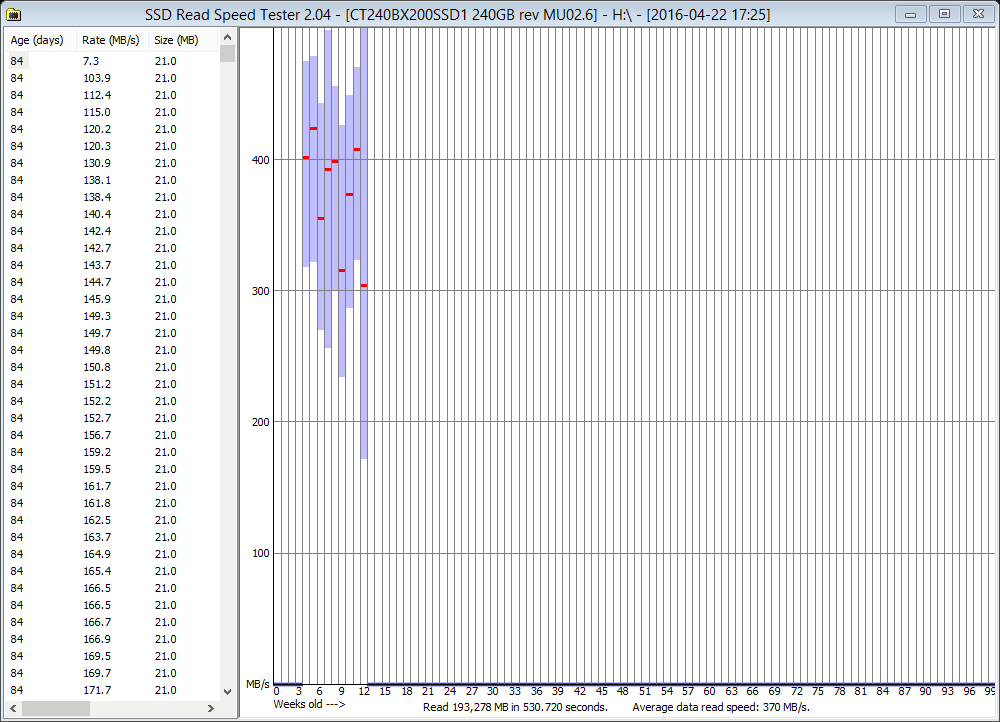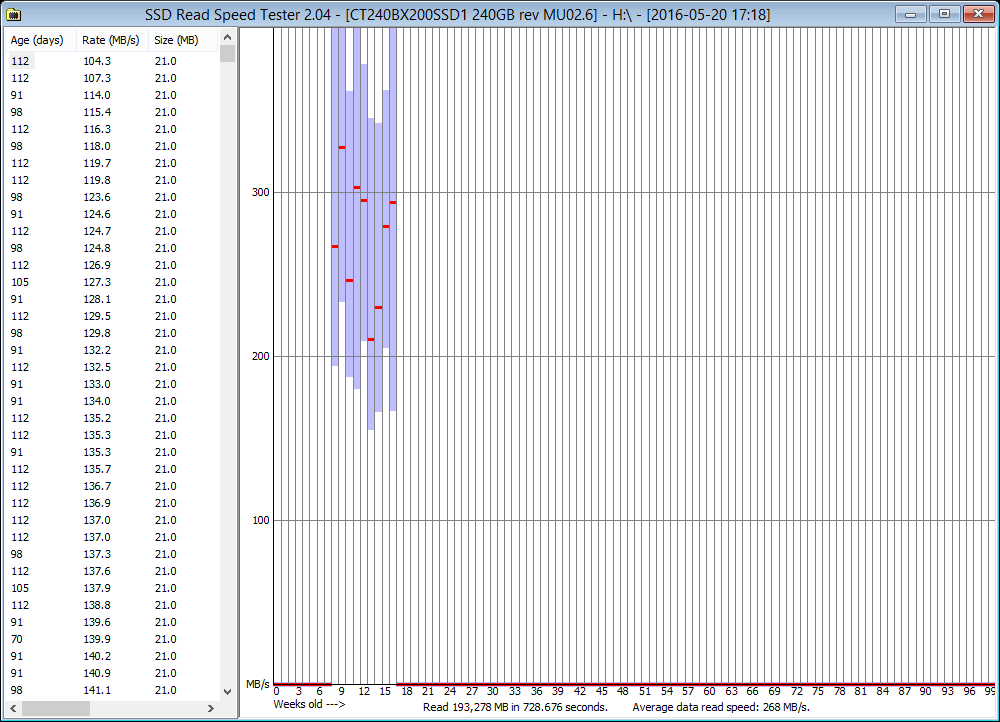- Mar 2, 2015
- 310
- 117
- 116
Some of you might remember the thread I created earlier about the ADATA SP550 suffering from read speed degradation.
In which I said I would test several SSDs to find out if they suffered from this issue as well and let you know if that was the case.
I'm still running my tests, but for one of these SSDs it's read speeds dropped so quickly I thought I should let you know.
As you may have already guessed considering the title of this thread that SSD is a Crucial BX200.
At first I thought that the results were due to HD Tune Pro sometimes needing some time to get warmed up.
However after three weeks of testing I analyzed the results a bit more closely and noticed that it read speeds went back to normal about the same time as it reached the unused areas of the SSD.
And as I got more results it became more and more clear that it's read speeds were dropping and dropping faster than those of any SSD I'm currently testing.
Here you can see the results of the tests I've performed every week to measure read speeds.

This is after one week and 20GB.
You can see that read speeds are back to normal around 20GB.

This is after two weeks and 40GB.
Read speeds recover at about 40GB.

This is after three weeks and 60GB.
Like with the others read speeds are fine after it reaches the unused portion of the SSD.
Here it is starting to become clear that read speeds are dropping thanks to that curve becoming a bit more uneven making it less likely that the earlier results were solely due to HD Tune Pro.

This is after four weeks and 80GB.
You can see that where there was a drop in read speeds earlier it has recovered quite a bit but at the same time read speeds for the more newly written sections are dropping.

This is after five weeks and 100GB.
Here you can see the biggest drop in read speeds so far which suggests that LDPC can raise read speeds but that the effect is temporary.

This is after six weeks and 120GB.
Don't know I have to add anything else other than that the read speeds keep dropping.

This is after seven weeks and 140GB.
Like before you can see that where before there was a particularly large drop in read speed it has recovered quite a bit at the same time read speeds for the more newly written sections are dropping.
I believe that the results from the first four weeks may be affected by HD Tune Pro right at the start of the read but even if I feel a bit skeptical of the really low read speeds right at the beginning you can still see that the read speeds have started to drop.
The results also show that they are dropping fast, with several examples of it dropping 50-100MB/s from one week to the next.
And even if LDPC ECC is better at adjusting for things like age and temperature than the more common BCH ECC and BX200 can use it to increase read speeds after I have read the entire SSD it doesn't prevent read speeds from dropping.
Perhaps you would like to know how I have tested the BX200 so far?
2016-01-29 I added one folder at 20GB filled with files at 20MB and after having left it unpowered for a week I tested its read speeds with HD Tune Pro 5.60 and added another folder at 20GB filled with files at 20MB.
Which has been repeated every week.
Other SSDs besides the BX200 may use the same NAND.
The Patriot Blast SSD does.
I suspect that for example the Corsair Force LE does.
And I have heard that ADATA intends to replace the SK Hynix NAND in the SP550 with the 16nm TLC NAND found in the BX200 if they haven't already.
While the ADATA SP550 is not particularly fast with the original SK Hynix NAND and can suffer from degraded read speeds in certain situations the NAND found in the BX200 is even slower and (according to these tests) significantly more prone to read speed degradation.
Let's put it this way: The BX200 has been the SSD for which read speeds have dropped the fastest of the SSDs I'm currently testing with the ADATA SP550 taking second place.
Read speeds for the ADATA SP550 have dropped by about 50MB/s over eight weeks of testing, while the BX200 has seen drops in read speeds over 100MB/s from one week to another.
And that's excluding the really low results because of the difficulty in determining if HD Tune Pro affected them.
Also note that both SSDs were tested in the same way and in the same conditions.
As I said earlier in the thread about the ADATA SP550 these results do not neccesarily mean that the BX200 has issues with low read speeds regardless of situation, most of which these tests do not cover.
That it is left without power for a week hardly affects its read speeds positively.
But the fact that I scan the entire SSD every week gives it the opportunity to identify and correct those areas with low read speeds which does affect read speeds positively.
Maybe it is just very sensitive to being left unpowered or that it needs time to go through the SSD when it is idling to fix this issue before it has gone as far as it already has.
But that hasn't been part of the tests I have performed (so far at least).
In which I said I would test several SSDs to find out if they suffered from this issue as well and let you know if that was the case.
I'm still running my tests, but for one of these SSDs it's read speeds dropped so quickly I thought I should let you know.
As you may have already guessed considering the title of this thread that SSD is a Crucial BX200.
At first I thought that the results were due to HD Tune Pro sometimes needing some time to get warmed up.
However after three weeks of testing I analyzed the results a bit more closely and noticed that it read speeds went back to normal about the same time as it reached the unused areas of the SSD.
And as I got more results it became more and more clear that it's read speeds were dropping and dropping faster than those of any SSD I'm currently testing.
Here you can see the results of the tests I've performed every week to measure read speeds.

This is after one week and 20GB.
You can see that read speeds are back to normal around 20GB.

This is after two weeks and 40GB.
Read speeds recover at about 40GB.

This is after three weeks and 60GB.
Like with the others read speeds are fine after it reaches the unused portion of the SSD.
Here it is starting to become clear that read speeds are dropping thanks to that curve becoming a bit more uneven making it less likely that the earlier results were solely due to HD Tune Pro.

This is after four weeks and 80GB.
You can see that where there was a drop in read speeds earlier it has recovered quite a bit but at the same time read speeds for the more newly written sections are dropping.

This is after five weeks and 100GB.
Here you can see the biggest drop in read speeds so far which suggests that LDPC can raise read speeds but that the effect is temporary.

This is after six weeks and 120GB.
Don't know I have to add anything else other than that the read speeds keep dropping.

This is after seven weeks and 140GB.
Like before you can see that where before there was a particularly large drop in read speed it has recovered quite a bit at the same time read speeds for the more newly written sections are dropping.
I believe that the results from the first four weeks may be affected by HD Tune Pro right at the start of the read but even if I feel a bit skeptical of the really low read speeds right at the beginning you can still see that the read speeds have started to drop.
The results also show that they are dropping fast, with several examples of it dropping 50-100MB/s from one week to the next.
And even if LDPC ECC is better at adjusting for things like age and temperature than the more common BCH ECC and BX200 can use it to increase read speeds after I have read the entire SSD it doesn't prevent read speeds from dropping.
Perhaps you would like to know how I have tested the BX200 so far?
2016-01-29 I added one folder at 20GB filled with files at 20MB and after having left it unpowered for a week I tested its read speeds with HD Tune Pro 5.60 and added another folder at 20GB filled with files at 20MB.
Which has been repeated every week.
Other SSDs besides the BX200 may use the same NAND.
The Patriot Blast SSD does.
I suspect that for example the Corsair Force LE does.
And I have heard that ADATA intends to replace the SK Hynix NAND in the SP550 with the 16nm TLC NAND found in the BX200 if they haven't already.
While the ADATA SP550 is not particularly fast with the original SK Hynix NAND and can suffer from degraded read speeds in certain situations the NAND found in the BX200 is even slower and (according to these tests) significantly more prone to read speed degradation.
Let's put it this way: The BX200 has been the SSD for which read speeds have dropped the fastest of the SSDs I'm currently testing with the ADATA SP550 taking second place.
Read speeds for the ADATA SP550 have dropped by about 50MB/s over eight weeks of testing, while the BX200 has seen drops in read speeds over 100MB/s from one week to another.
And that's excluding the really low results because of the difficulty in determining if HD Tune Pro affected them.
Also note that both SSDs were tested in the same way and in the same conditions.
As I said earlier in the thread about the ADATA SP550 these results do not neccesarily mean that the BX200 has issues with low read speeds regardless of situation, most of which these tests do not cover.
That it is left without power for a week hardly affects its read speeds positively.
But the fact that I scan the entire SSD every week gives it the opportunity to identify and correct those areas with low read speeds which does affect read speeds positively.
Maybe it is just very sensitive to being left unpowered or that it needs time to go through the SSD when it is idling to fix this issue before it has gone as far as it already has.
But that hasn't been part of the tests I have performed (so far at least).
Last edited:






